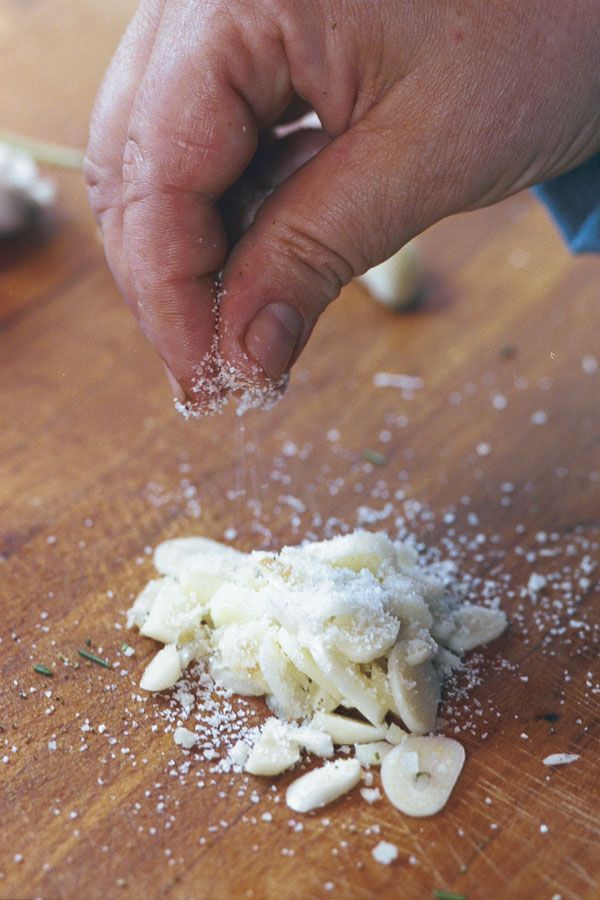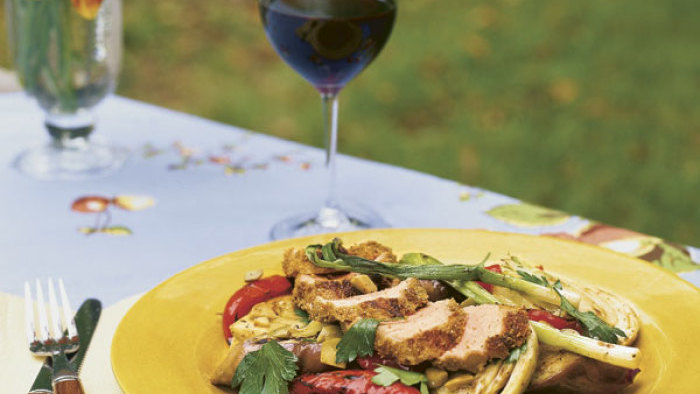
Roasting vegetables is an act of culinary magic. This basic process enhances and intensifies the flavors of nearly every vegetable. Tomatoes slowly shrink, their flavors concentrating to a sweet potency. Roasted peppers take on a strong, earthy taste. The magic lies in simplicity—as few as three ingredients can create a full-flavored dish: oil, salt, and the vegetable itself. You can also elaborate on the flavor theme with an ensemble of herbs, spices, and vinegars. But I usually prefer to let a vegetable’s own flavors sing, and sing they will if the vegetable’s gone directly from garden to kitchen with little ado.
By definition, roasting involves cooking food uncovered in an oven or by exposure to open heat. Most references to roasting refer to a method involving meat, but in recent years, roasted root vegetables have become quite the rage—and for good reason. Roasting needn’t be bound by definition or by trends. Most of your summer produce will respond delectably to roasting, with luscious and healthful results.
Slow or fast, roasting yields great flavor
You can roast vegetables in a slow oven, up to 325°F, or a fast oven, with a temperature as high as 500°F. The oven temperature will depend on the type of vegetable, as some work best with long, slow cooking and others with quick, hot methods. Slow roasting works especially well with carrots or other root vegetables. Many vegetables are easily adapted to a range of temperatures; you should feel free to experiment with your fresh produce.
Roasting temperature will affect the vegetables’ final taste. Lower temperatures dehydrate vegetables and sweeten their flavor; medium range temperatures cook evenly throughout and round out the flavor of the vegetables; and high, quick heat usually caramelizes vegetables but leaves them juicy and al dente.The secret to great roasted vegetables is to use impeccably fresh produce; seasonal produce is usually most flavorful.
Some of you will balk at the idea of turning on your oven in the warm weather, but there are benefits to roasting versus grilling. With grilling, smaller sized vegetables will fall through the grill grates (unless you have a grilling basket). Grilling gives a delicious smoky and charred flavor, but that’s not always the taste you want for your menu. And not everyone has a grill, especially those who live in apartments. Even if you do grill, it’s not always easy or convenient to light a wood- or charcoal-fired grill.
 |
|
| A little olive oil, rosemary, vinegar, salt, and garlic will imbue rapid-roasted tomatoes with added flavor. | |
[[[PAGE]]]
Oven roasting can be completed in as little as 10 minutes in a preheated oven and can be done ahead of time. Then the vegetables can be brought back to room temperature or reheated. As long as you have an oven, even a small toaster oven, you can roast vegetables. If you’re lucky enough to own a convection oven, by all means, use that; it circulates heated air around the oven’s interior, creating perfect roasting conditions. Convection heat works well at all temperatures. With slow roasting, the warm moving air gently dehydrates the vegetables. At moderate temperatures, vegetables cook evenly for maximum flavor. And at high temperatures, convection intensifies the heat and rapidly caramelizes or chars the vegetables.
Sliced just right
| Chef Carole Peck, of Good News Cafe in Woodbury, Connecticut, offers some of her favorite recipes… • Roasted Asparagus • Roasted Cauliflower • Slow-Roasted Tomatoes • Rapid-Roasted Tomatoes • Basic Cornbread • Sandwich of Cornbread, Goat Cheese, and Slow-Roasted Tomatoes |
|
You can roast all types and sizes of vegetables on a baking sheet or in a shallow pan, and you can vary tastes depending on the cooking temperature and added flavorings. But what do you do when you want to roast a couple of vegetables together at the same time? How do you coordinate the cooking time for each? The best way is by controlling the size of the vegetable. This applies to both whole vegetables and ones that need to be cut up.
When you’re roasting just one vegetable, choose pieces of similar size. For instance, when you go out to your asparagus bed to harvest the evening’s star attraction, choose asparagus spears of similar girth.
When you’re cooking a vegetable medley, you can keep checking periodically to see if any are done, removing them as you go along. But this can be troublesome. Instead, take the time to cut slower-cooking vegetables into smaller pieces than quick-cooking vegetables.
[[[PAGE]]]
Tasty additions
From olive oil to a pesto rub, additions make a difference. It also matters when in the roasting process you add them. Fresh-from-the-garden vegetables are often so flavorful that masking them with lots of seasoning seems a sin. Sometimes all that’s needed is a brushing with oil, a twist of fresh pepper, and a sprinkle of salt. Olive oil keeps the exterior of vegetables from drying out, while the salt draws out some moisture, concentrating the flavors of the vegetables so they’re sweet and intense.
 |
|
| After slicing garlic, sprinkle it with coarse salt to keep it from sticking to your knife and your fingers while you mince it. | |
There’s a world of seasonings beyond oil, salt, and pepper, and with any luck, it’s right outside your door in your herb garden. Some fresh herbs, such as rosemary, hold up well to roasting. More delicate, succulent green herbs do not and may lose flavor or blacken. Fresh dill, basil, and parsley should be added once the dish is out of the oven. Oregano, thyme, marjoram, and sage will hold up to some roasting, especially if coated with oil.
Garlic can serve as a seasoning or as the main ingredient of a side dish. Roasting subdues garlic’s pungent heat, so it’s a great way to cook this allium. Beware, however, of roasting garlic—especially minced garlic—at high temperatures for more than 10 to 15 minutes; the garlic will burn and taste acrid and unappealing. To prevent this, add minced garlic to sliced, moist vegetables, or toss the ingredients with a bit of olive oil. If you’re working with larger cuts of vegetables, consider using whole cloves of garlic.
Hot peppers like serranos or cayennes can be roasted with a main vegetable. The pepper will impart a fieriness to whatever it’s tossed with. Curry powders or savory spice blends mixed with oils are tasty additions. Sesame or nut oil imparts its own flavor. Vinegar or citrus juice heightens and intensifies the flavor of the vegetable. Soy sauce gives ingredients a distinctive Asian taste. Small amounts of sugar, honey, and maple syrup sweeten and aid in caramelization. Don’t hesitate to experiment.
And two more roasting tips. . .
When prepping vegetables for roasting, wash and drain them well, then pat them dry with paper towels. Excess water can cause vegetables to steam rather than roast. Spread vegetables out in just one layer in a roasting pan or on a baking sheet; you want them to fit snugly.
I’m a great believer in planning ahead. Many vegetables can be roasted one day ahead and then reheated close to serving time in a 400°F degree oven.
Remember, you have a lot of choices with roasting, and most vegetables will respond well to different temperatures and different cooking times. Be sure to let the flavor of the vegetables sing.
| Visit FineCooking.com’s Essential Guide to Roasting Vegetables and get more than 50 FineCooking.com recipes for roasted vegetables. |
by Carole Peck
April 1999
from issue #20
Fine Gardening Recommended Products

A.M. Leonard Deluxe Soil Knife & Leather Sheath Combo
Fine Gardening receives a commission for items purchased through links on this site, including Amazon Associates and other affiliate advertising programs.

Chapin International 10509 Upside-Down Trigger Sprayer
Fine Gardening receives a commission for items purchased through links on this site, including Amazon Associates and other affiliate advertising programs.

Gardener's Log Book from NYBG
Fine Gardening receives a commission for items purchased through links on this site, including Amazon Associates and other affiliate advertising programs.



















Comments
Log in or create an account to post a comment.
Sign up Log in